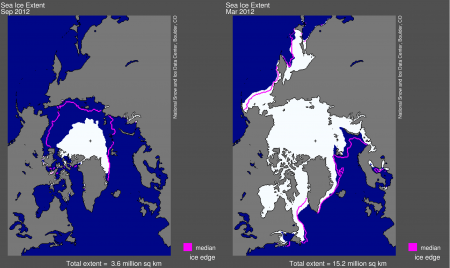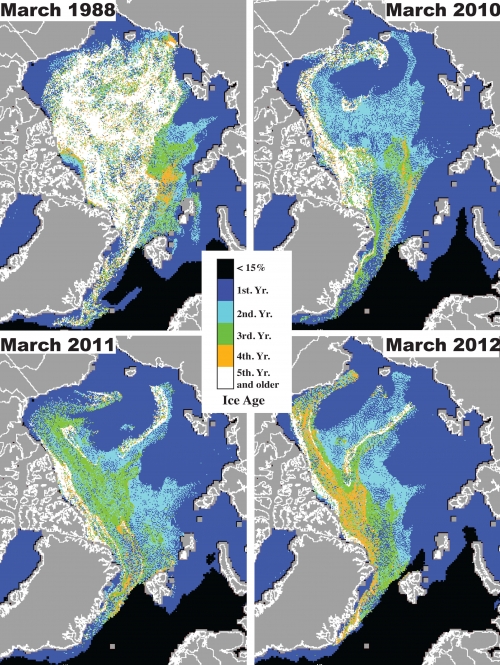In November 2012, the Polar Research Board (PRB) of the U.S. National Academy of Sciences issued the report, Seasonal to Decadal Predictions of Arctic Sea Ice: Challenges and Strategies, which explores major challenges in sea ice prediction, and identifies methods, observations, and technologies that might advance capabilities to predict the extent of sea ice.
Dramatic reductions in the extent and thickness of ice in the Arctic (see Figure 1) affect a growing community of diverse stakeholders, including indigenous populations, natural resource industries, fishing communities, commercial shippers, marine tourism operators, national security organizations, regulatory agencies, and the scientific research community. The reductions in ice extent and thickness can lead to a wide array of impacts such as marine mammal habitat changes, circulation shifts in the ocean and atmosphere, and challenges for subsistence hunters, which has created an urgent need for better predictions of future sea ice conditions.

There are several key overarching challenges, not unique to the topic of sea ice prediction, that hinder advancements in our predictive capabilities:
Understanding the Interactions Among the Various Parts of the Arctic System
Sea ice is just one part of the larger arctic system, which includes components such as ocean currents, atmospheric conditions, land cover, and the arctic food web. Changes in any one of these components can influence other parts of the system, but interactions between the various parts of the system are not fully understood. Adding to the complexity is the fact that humans have an increasingly large role in the ecosystem, for example by causing oil spills or through greenhouse gas emissions.
Enhancing Sea Ice Prediction Models to Reflect Changing Characteristics of Sea Ice
Recent reductions in the extent of summer sea ice have also caused shifts in the composition of the ice. Dominated by thick, multi-year ice just a decade ago, thinner first year ice now makes up an increasingly large part of the ice cover (see Figure 2). First-year sea ice is more susceptible to summer melt, and is more easily ridged, ruptured, and moved by winds, which has important implications for predicting future sea ice cover. Many current sea ice models use formulations and parameters based on data collected during the multi-year sea ice regime and may not accurately reflect recent changes in sea ice characteristics.
Meeting the Needs of a Wide Range of Stakeholders
Clearly defining the broad and evolving needs of stakeholders would help inform future directions for sea ice modeling and observations in support of sea ice prediction.

There are also challenges in advancing predictive capabilities specific to seasonal and decadal timescales:
Understanding the Relative Accuracies, Strengths, and Weaknesses of the Different Approaches Used to Forecast Seasonal Ice
Currently, the three approaches for seasonal forecasts are: (1) statistical models; (2) coupled ice-ocean models; and more recently, (3) coupled atmosphere-ocean-ice models.
Knowing the Degree of Precision Required in Characterizing Initial Ice-ocean Conditions in Order to Generate Accurate Seasonal Predictions
Few experiments have been performed to investigate exactly how to optimize sea ice observations. For example, there is little information on what observational quality, spatial density, location and accuracy are required for different variables. Furthermore, obtaining the data quickly enough to make seasonal predictions can be challenging.
Improving Simulation of Realistic Climate Forcings from the Atmosphere and Ocean by Using Coupled Climate Models, and Identifying the Model Variables and/or Processes that Contribute to Unrealistic Simulations
Coupled climate models that are used to generate decadal sea ice predictions generate their own atmospheric and oceanic variables from the basic laws of physics. Any errors in the variables used to drive sea ice, however, can lead to unrealistic sea ice distributions. Simulating realistic atmospheric and oceanic conditions depends on assumptions about future trends in carbon dioxide emissions, aerosol loading, changing surface characteristics, and other factors.
The report also identifies steps that could be taken to advance sea ice prediction over seasonal to decadal time scales. Chief among them is to establish sustained and coordinated collaboration among the sea ice data user, modeling, and observation communities. This collaboration could help reveal gaps in understanding, help balance the needs and expectations of different stakeholders, and ensure that resources are allocated to address the most pressing sea ice data needs. In addition, given the vast amounts of data on arctic sea ice and the numerous stakeholders who use these data, there is a need for a coordinated and centralized information hub that facilitates timely access to observational and modeling results, unifying the various databases and providing a consistent system for finding and accessing data.
Other important strategies to significantly enhance our understanding and predictions of arctic sea ice cover include:
Evaluation of the different methods for forecasting seasonal sea ice. Understanding each method’s weaknesses and strengths could help scientists determine which method for forecasting sea ice is best suited for informing different stakeholders.
Coordinated process-based study of seasonal sea ice. It is necessary to understand the impact of the increasing predominance of younger, first-year ice on sea ice predictions. Process-based studies also offer an opportunity to identify, develop, and test observational instruments.
Model sensitivity studies to determine key first-order observational needs. These studies will help scientists understand how much specific variables impact model simulations, aid in prioritizing observational needs (e.g., observation types, locations, and coverage), and be useful for advancing the design of the Arctic Observing Network.
Coordinated experiment with multiple numerical models. The identification of the model components that are critical to simulating a realistic ice cover will also guide decisions regarding high priority model development needs and the expansion of models to include additional capabilities and variables of interest to stakeholders.
The report is available as a free PDF here. To purchase paper copies, please contact the National Academies Press at: 800-624-6242.
The PRB is a unit within the National Academies and is responsible for studies related to the Arctic, Antarctic, and cold regions in general. More information about the PRB and other related activities can be found here.
